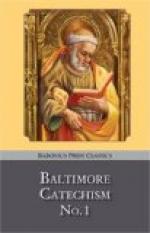249 Q. When did Christ give His priests the power to change bread and wine into His body and blood? A. Christ gave His priests the power to change bread and wine into His body and blood when He said to His Apostles, “Do this in commemoration of Me.”
250 Q. How do the priests exercise this power of changing bread and wine into the body and blood of Christ? A. The priests exercise this power of changing bread and wine into the body and blood of Christ through the words of consecration in the Mass, which are the words of Christ: “This is My body; this is My blood.”
“Consecration.” At what part of the Mass are the words of consecration pronounced? Just before the Elevation; that is, just before the priest holds up the Host and the chalice, while the altar boy rings the bell.
When the priest is going to say Mass he prepares everything necessary in the sacristy—the place or room near the altar where the sacred vessels and vestments are kept, and where the priest vests. He takes the chalice—that is, the long silver or gold goblet—out of its case; then he covers it with a long, narrow, white linen cloth called a purificator. Over this he places a small silver or gold plate called the paten, on which he places a host—that is, a thin piece of white bread prepared for Mass, perfectly round, and about the size of the bottom of a small drinking glass. He then covers this host with a white card, called a pall, after which he covers the chalice and all with a square cloth or veil that matches the vestments. Then he puts on his own vestments as follows: Over his shoulders the amice, a square, white cloth. Next the alb, a long white garment reaching down to his feet. He draws it about his waist with the cincture, or white cord. He places on his left arm the maniple, a short, narrow vestment. Around his neck he places the stole, a long, narrow vestment with a cross on each end. Over all he places the chasuble, or large vestment with the cross on the back. Lastly, he puts on his cap or biretta. Before going further I must say something about the color and signification of the vestments. There are five colors used, namely, white, red, green, violet, and black. White signifies innocence, and is used on the feasts of Our Lord, of the Blessed Virgin, and of some saints. Red signifies love, and is used on the feasts of the Holy Ghost and of the martyrs. Green signifies hope, and is used on Sundays from the Epiphany to Pentecost, unless some feast requiring another color falls on Sunday. Violet signifies penance, and is used in Advent and Lent. Black signifies sorrow, and is used on Good Friday and in Masses for the dead. As regards the vestments themselves: the amice signifies preparation to resist the attacks of the devil; the alb is the symbol of innocence; the cincture of charity; the maniple of penance; the stole of immortality; and the chasuble of love, by which we are enabled to bear the light burden Our Lord is pleased to lay upon us.




